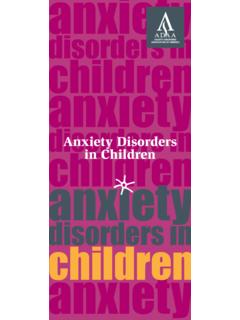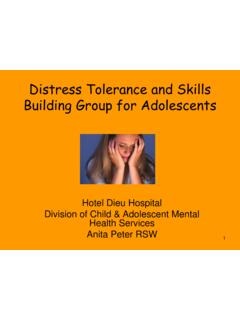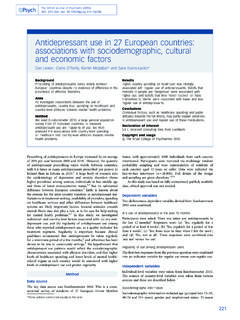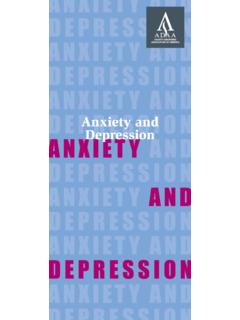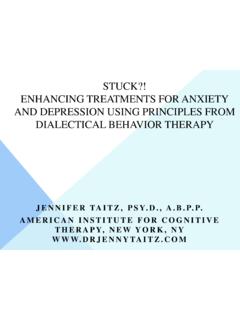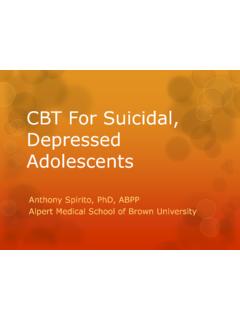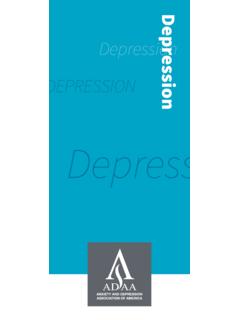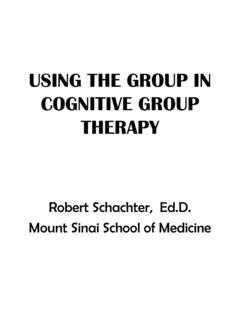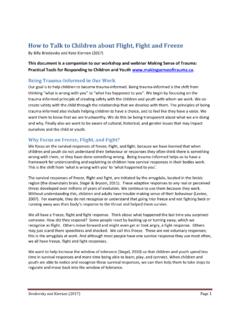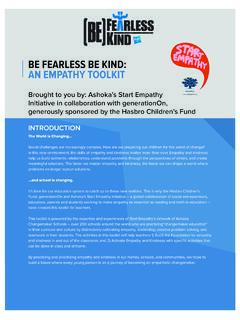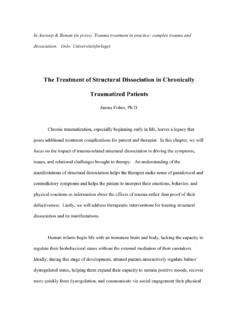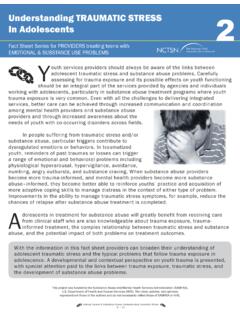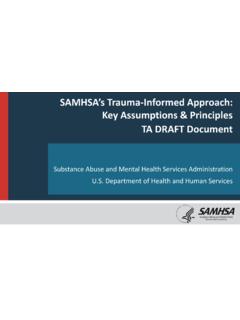Transcription of Explaining Anxiety in the Brain - Anxiety and Depression ...
1 Explaining Anxiety in the Brain : Explanations for children and Adults that Enhance Treatment Compliance in A Whole Brain Approach Catherine M. Pittman, Saint Mary s College Notre Dame, IN & Jamie L. Rathert, University of Tennesssee Knoxville, TN April 14, 2012 Anxiety Disorders Association of America 32nd Annual Conference No Disclosures. Anxiety in the We know more about the neuropsychological basis of Anxiety than we do about any Are we effectively using this knowledge for our clients benefit?
2 What level of explanation is valuable and helpful, and how much neurology is too much? Too much complexity and detail can cause a client s eyes to glaze over! Note: See Extinguishing Anxiety : Whole Brain Strategies to Relieve Fear and Stress Explaining Brain Processes that Underlie Anxiety Disorders Parsimony (simplicity) is key Clarity of explanation Explanations may be spread across sessions Choose language that is useful in motivating clients Use metaphors that are helpful, encouraging Note: See Extinguishing Anxiety .
3 Whole Brain Strategies to Relieve Fear and Stress Goals of Explaining Brain Functions Underlying Anxiety Disorders Provide explanations that reduce Anxiety Increase client understanding of Anxiety in the Brain why treatment is effective how medications affect Anxiety Increase willingness to comply with treatment Increase use of treatment strategies Explanations that Reduce Client s Anxiety Explaining the fight / flight / freeze Response Helps client understand source/purpose of symptoms Helps client recognize meaning of symptoms Reduces catastrophizing Helps client recognize what responses can be controlled and what ones cannot Helps identify relevant coping responses Explanations that Help Client Understand Anxiety in the Brain Introducing the Amygdala The part of the Brain that creates, maintains, or modifies Anxiety and fear responses Contrast with The Cortex The Cortex.
4 The Thinking Brain Reasoning, Logic Conscious Memories Awareness Detailed Information The Amygdala Almond-shaped structure that serves as an alarm system in the Brain Other functions, too, but scans for danger signals Capable of turning on the fight / flight / freeze Response in a matter of milliseconds The amygdala has extensive connections can influence sympathetic nervous system, hormones, cortex The amygdala that we each inherit may be more or less sensitive to potential danger Locating the Cortex and the Amygdala Express Lane vs.
5 The Local Lane The amygdala makes it possible for us to respond to a danger before we know what the danger is Information from the senses is relayed directly to the amygdala from the thalamus The amygdala can initiate a well-coordinated response to danger BEFORE the person completely understands the danger The Express Lane vs. the Local Lane Two Separate Systems to Consider: Amygdala and Cortex The amygdala is able to produce fear/ Anxiety responses without the involvement of the cortex The amygdala can, in fact, override the cortex and influence or even control our thoughts and focus of attention The cortex can also initiate Anxiety responses by alerting the amygdala to potential dangers Two Separate Systems to Consider.
6 Amygdala and Cortex These two systems operate independently and on different schedules The amygdala can override the cortex at times Relate to client s experiences The amygdala has information not available to cortex ( , Korsakoff s, cortical blindness) Proposal: When it comes to fear/ Anxiety , we have an emotional Brain as well as a thinking Brain . We need to address both. Let s start by addressing the Amygdala First, we will explain how the amygdala creates and maintains Anxiety and how these responses can be changed.
7 How the Amygdala Creates the Anxiety Response Some fears are wired in to the amygdala Snakes, heights, being watched by others Other fears are learned and stored by the amygdala The amygdala does not learn the way the cortex learns The amygdala learns through experience on the basis of *pairings* (not logic) Negative Event Trigger Fear Discomfort Classical Conditioning (The Language of the Amygdala) The Language of the Amygdala Associative Learning: based on pairings Experience is required for learning to occur Some pre-wired exceptions Logic and Lectures don t promote learning The amygdala must be activated for learning to occur Activate to Generate new connections This means one is likely to feel Anxiety The Language of the Amygdala Exposure Techniques The best way to change the circuitry in the amygdala, The amygdala learns through experience In order for the amygdala to form new memories about the Trigger.
8 Specific circuitry in the amygdala must be activated by the Trigger *Benefit: Exposure is more tolerable when clients know they re using the language of the amygdala Negative Event Trigger Fear Discomfort Calm Fear Impact of Exposure Benefits of Language of the Amygdala Approach: Perspective Clients realize an isolated part of their Brain is malfunctioning they aren t crazy Clients recognize that multiple perspectives on their Anxiety experience are possible Clients become capable of having a different relationship to experience of Anxiety In a manner similar to mindfulness approaches, client is able to observe the reaction of the amygdala Benefits of Language of the Amygdala Approach.
9 Enhanced Motivation Clients have a clear objective in seeking exposure experiences Communicating with the amygdala in its own language Clients can see the discomfort of exposure in a new light: Activating to Generate Activating the amygdala allows client to generate new connections in the Brain The Amygdala s Relationship to the Cortex Processes information faster than the cortex and acts on it before cortex can Uses information that is less detailed and specific, so fears generalize Can override the cortex and produce reactions, responses that aren t logical Once the amygdala has activated a panic response.
10 The cortex is not very effective in coping The Amygdala s Relationship to the Cortex (cont.) Cannot be directly controlled by the cortex or deliberate thought processes Can be influenced by the cortex and respond to imagined dangers Knowing when amygdala is producing responses and when cortex is initiating the amygdala s response is helpful Help client understand the difference Cortex-based Approaches Best used before the amygdala has activated an Anxiety response Once the amygdala has been activated.
